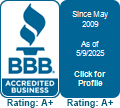
A furnace is almost always a background player at home, keeping you warm in the cold winter months. It often won't be noticed until a malfunction appears.
One source could be that your furnace has a cracked heat exchanger. It can be a safety risk, so it’s worthwhile to learn the evidence of a cracked heat exchanger and what to do if you believe that may be the problem.
What Is a Heat Exchanger in a Furnace?
A heat exchanger helps transition heat from the combustion chamber inside your furnace to the air that flows inside the air ducts. It typically handles this through coils or tubes that heat the air while functioning as a barrier to keep gas formed in the combustion chamber, called flue gasses, from leaking out into your home.
Is a Cracked Heat Exchanger Dangerous?
Because of its important role, it’s no surprise that a cracked heat exchanger can be hazardous. A damaged heat exchanger can permit dangerous gasses – like carbon monoxide, which can be lethal – to circulate across your home.
For obvious reasons, do NOT run your heater if you suspect it has a cracked heat exchanger, as letting it run could make the entire family ill. Reach out to an HVAC professional as soon as possible if you believe your heating has a cracked heat exchanger that should be repaired.
Four Signs of a Cracked Heat Exchanger:
- Furnace shuts off: Cracks in the heat exchanger can cause your furnace to shut off.
- Unusual Smells: If the air leaving your furnace has a strong chemical odor, it may be evidence gas is slipping through cracks in your heat exchanger. These gasses, which will often smell like formaldehyde, are a common warning sign.
- Carbon monoxide alarm is triggered or you recognize poisoning symptoms: If a cracked heat exchanger is emitting carbon monoxide into your home, your carbon monoxide alarm could go off or family members may struggle with signs of carbon monoxide poisoning. Complications include headaches, dizziness, weakness, nausea, vomiting or feeling sleepy. If the alarm goes off or you feel unusually tired, leave the home as soon as you can and then call for help.
- Soot: If you notice black sooty collecting near the exterior of your furnace, it’s another sign something could be seriously wrong.
What to Do if a Furnace Heat Exchanger is Cracked
If you believe your furnace has a cracked heat exchanger, hire a professional well versed in furnace installation West Valley City right away so they can take a look at your system and, if needed, start a furnace heat exchanger replacement. Costs often differ depending on the situation, but estimates can roughly suggest $1,000 to $3,000.
Fortunately, the good news is that heat exchangers are often included in the warranty. You should check the warranty paperwork on your furnace, since while the warranty may not cover the entire cost of repairs, it still may significantly shrink your bill.
How to Avoid a Cracked Heat Exchanger in Your Home
One of the best ways to minimize the risk of problems in your furnace overall is through routine furnace maintenance. Furnaces provide the best possible return on investment when they operate efficiently. Hiring a skilled professional to examine your furnace for broken-down parts, clogs in the air filters and other likely problems can keep you from getting a big bill later on.
It’s also beneficial to review your furnace filters every few months – it’s ideal some filters be replaced every 90 days or sooner if they are dirty or grimy. While the filters are not part of the heat exchanger itself, the strain of dragging air through a clogged filter makes the entire furnace work more vigorously to accomplish its job. And the harder your furnace needs to run, the more strain components like the heat exchanger will sustain.

